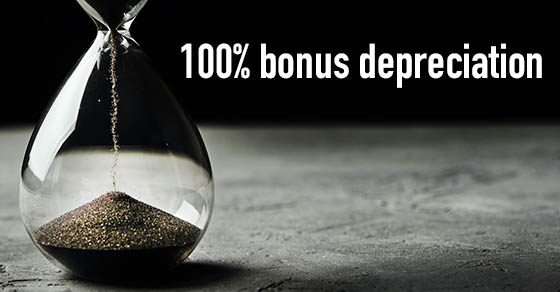Businesses must act now to make the most out of bonus depreciation – part two

The potential business value of bonus depreciation for taxpayers rose significantly with the Tax Cuts and Jobs Act (TCJA), but only for a brief time. After 2022, the percentage of first-year depreciation that can claim a “bonus” will decline from 100%. Therefore, businesses should make necessary preparations.
Bonus depreciation vs. Section 179 expensing
Taxpayers occasionally mistake Sec. 179 expensing for bonus depreciation. Although comparable, the two tax benefits are different.
Sec. 179 permits a taxpayer to write off the total cost of new and used qualified assets, similar to bonus depreciation. Software, computer and office equipment, certain cars and machinery, and qualified improvement property are examples of eligible assets.
However, some restrictions on Sec. 179 do not apply to bonus depreciation. For instance, $1.08 million is the highest deduction you can take in 2022.
Additionally, because the deduction intends to help small and medium-sized enterprises, it starts to phase down when eligible property acquisitions surpass $2.7 million, dollar for dollar. In other words, the deduction is not available if the cost of the Sec. 179 property used this year is $3.78 million or more.
The amount of a business’s taxable income also determines the Sec. 179 deduction’s cap; thus, using the deduction cannot result in a loss for the company. There is no limit to the number of years you can carry over an item of expenditure to the following year if it is not deductible in the initial year. However, such carried-over costs must be deducted according to age. So, costs carried over from 2019 must be deducted before those carried over from 2020.
The company may also deduct the surplus as bonus depreciation in the first year. For example, consider the following scenario: You spend $20,000 on equipment, but your total income for the year it is used is only $15,000. Therefore, you may deduct $15,000 under Section 179 and the remaining $5,000 as bonus depreciation if you are otherwise qualified.
In addition, the Sec. 179 deduction is not automatic, unlike bonus depreciation. You must claim it on a property-by-property basis.
Some caveats
Bonus depreciation can seem like a no-brainer at first. Nevertheless, it might not always be a good idea.
For instance, bonus depreciation may not benefit taxpayers who claim the qualified business income (QBI) deduction for pass-through enterprises. Your taxable income, which will decrease by bonus depreciation, is the cap on the QBI deduction amount. Similar to bonus depreciation, you may want to use the QBI deduction to its fullest before its expiration in 2026.
Tax benefits other than the QBI deduction also rely on taxable income. In addition, increasing your depreciation deduction can reduce the value of carryforwards for charitable contributions and credits and expired net operating losses.
Additionally, schemes for accelerating deductions should constantly consider projected changes in tax brackets. Any deduction has greater worth when subject to higher tax rates. For instance, younger companies with lower incomes today might want to spread depreciation. However, it would be best to consider the upcoming reductions in the maximum deduction amounts when using bonus depreciation.
The business value of bonus depreciation
To make the most of your options, buying bonus depreciation-eligible property and putting it to use before the year is out could be a good idea. Based on your unique situation and anticipated tax law changes, we can assist you in choosing the best course of action. Contact our RRBB accountants and advisors today.
For more information on the bonus depreciation deduction, read part one of this two-part series: http://rrbb.com/businesses-bonus-depreciation-deduction/.
© 2022
RRBB eNEWSLETTER
Get free tax planning and financial advice




